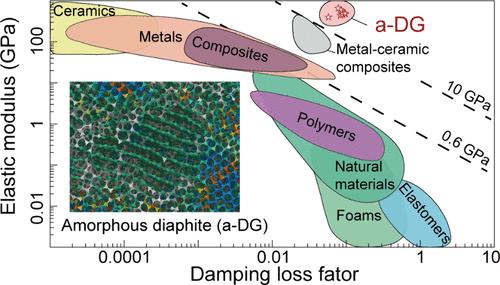非晶隔膜的阻尼和刚度同时增强
IF 16
1区 材料科学
Q1 CHEMISTRY, MULTIDISCIPLINARY
引用次数: 0
摘要
高性能阻尼材料在许多应用中都是至关重要的,然而传统材料往往面临阻尼性能和刚度/强度之间的基本权衡。由于材料的阻尼性能依赖于其内部的粘弹性能量耗散,因此它不利于阻尼材料承受高机械载荷。最近,一种被称为非晶隔膜(a- dg)的非晶碳被报道,它具有纳米金刚石和无序多层石墨烯(ND/DMG)的非均相组成。a- dg表现出不同的微观结构拓扑和综合特性,使其成为在高刚度/强度材料中实现高效耗能的有希望的候选者。在此,我们进行了基于原子的模拟来阐明具有可调谐两相结构的a- dg的力学和阻尼特性。利用循环载荷和voight - reuss - hill理论,我们发现a- dg同时表现出卓越的刚度和阻尼能力,由于重量轻,具有优异的比弹性模量(2.39-3.25 g/cm3)。这种优异的性能归因于柔性DMG和刚性ND晶粒的平衡组合,这可以通过表现杂交来调节。具体而言,集中的剪切应变、相变和界面杂化键转换通过各种松弛机制显著增强了内摩擦,ND晶粒通过阻断剪切带的传播确保了高刚度。本文所获得的见解将为高性能阻尼材料的设计和应用提供理论支持,并为研究其他非晶碳开辟了一个诱人的前景。本文章由计算机程序翻译,如有差异,请以英文原文为准。

Simultaneously Enhanced Damping and Stiffness of Amorphous Diaphite
High-performance damping materials are crucial for numerous applications, yet traditional materials often face a fundamental trade-off between the damping properties and stiffness/strength. Since damping properties of material rely on its inner viscoelastic energy dissipation, it is antagonistic for damping material sustaining high mechanical loads. Recently, an amorphous carbon known as amorphous diaphite (a-DG) was reported, featuring a heterogeneous two-phase composition of nanodiamonds and disordered multilayer graphene (ND/DMG). The a-DG demonstrated diverse microstructure topologies and integrated characteristics, making it a promising candidate for achieving efficient energy dissipation in high-stiffness/strength materials. Herein, we conducted atomistic-based simulations to elucidate the mechanical and damping properties in a-DGs with tunable two-phase structures. Utilizing cyclic loads and Voigt–Reuss–Hill theory, we found that a-DGs exhibit surpassing stiffness and damping capabilities simultaneously, with excellent specific elastic modulus due to lightweight (2.39–3.25 g/cm3). The distinguishing performance is attributed to a balanced combination of flexible DMG and stiff ND grains, which can be tuned through manifesting the hybridization. Specifically, the concentrated shear strains, phase transformation and interfacial hybrid bond conversion significantly enhance internal friction through various relaxation mechanisms, while ND grains ensure high stiffness through blocking the propagation of shear bands. The insights obtained here should provide theoretical support for the design and application of high-performance damping materials, opening up an enticing perspective for investigating other amorphous carbons.
求助全文
通过发布文献求助,成功后即可免费获取论文全文。
去求助
来源期刊

ACS Nano
工程技术-材料科学:综合
CiteScore
26.00
自引率
4.10%
发文量
1627
审稿时长
1.7 months
期刊介绍:
ACS Nano, published monthly, serves as an international forum for comprehensive articles on nanoscience and nanotechnology research at the intersections of chemistry, biology, materials science, physics, and engineering. The journal fosters communication among scientists in these communities, facilitating collaboration, new research opportunities, and advancements through discoveries. ACS Nano covers synthesis, assembly, characterization, theory, and simulation of nanostructures, nanobiotechnology, nanofabrication, methods and tools for nanoscience and nanotechnology, and self- and directed-assembly. Alongside original research articles, it offers thorough reviews, perspectives on cutting-edge research, and discussions envisioning the future of nanoscience and nanotechnology.
 求助内容:
求助内容: 应助结果提醒方式:
应助结果提醒方式:


